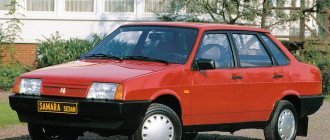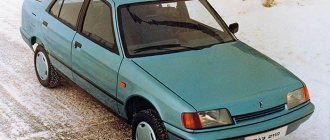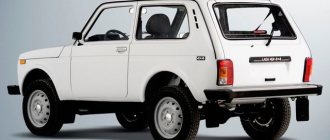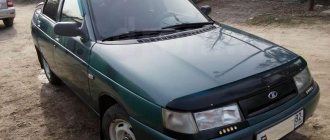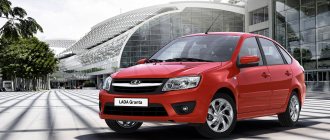The VAZ 2115 or tag is a representative of the Samara-2 or Lada Samara family of models, which replaced the Lada Sputnik. These machines began to be produced in 1997 as pilot production, and in 2000 they were put on the assembly line, but production was stopped in 2012. For the VAZ 2115 car, technical specifications are given in relation to the body, interior, engine and chassis.
VAZ 2115 configurations
This popular descendant of the VAZ 21099, a prominent representative of the Samara-2 family, is a compact B class sedan.
Produced from 1997 to 2012 in three main trim levels:
- “Standard” VAZ 21150-20-ST;
- “Norma” VAZ 21150-21-NR;
- "Lux" VAZ 21150-22-LX.
The 20-ST package did not include any additional elements or options other than standard seat belts and electric door locks. The interior is without any special decorative details, with tweed seat upholstery and solid fabric inserts on the side panels.
With the advent of the “21–NR” (standard) configuration, the car was equipped with fog lights, seat belt warning lights and heated front seats. The electrical equipment was supplemented with front door window lifts.
The most equipped car was the Luxury class car (22-LX). In addition to everything that was in previous trim levels, buyers now have a choice of interior trims. The seat upholstery was made not only of tweed material, but also of velvet.
The level of car safety has increased thanks to the built-in ABS (anti-lock braking system). Installing power steering made the car easy to control and maneuverable.
In addition there were:
- rear side window lifts;
- heated rear seats;
- headlight cleaners;
- factory tinted windows.
Are VAZs still produced today?
Do VAZ now produce cars under their main brand? As you know, after the global economic crisis, the company came under state control, as it owed its investors about 14.5 billion rubles. Officials decided to subsidize the concern and provide an interest-free loan of 60 billion (through Russian Technologies). At the moment, Renault owns 50% of the shares (minus 1 share). The remaining share is from Russian investors and Nissan.
Differences between the model and its predecessors
It is worth noting that this car has undergone the most significant changes in comparison with previous representatives of the line. The car body was completely modernized: it acquired smoother contours and became 22 centimeters longer.
The front of the car acquired original narrow headlights, the shape of the hood and front fenders changed. The bumpers took on modern shapes and began to be painted in body color, and additional brake lights appeared on the rear spoiler. The rear lights were supplemented with intermediate inserts, which increased the attractiveness of the rear of the car.
The trunk volume and carrying capacity of the vehicle have increased. The interior of the car has also changed, which is complemented by an updated dashboard and improved seats. The built-in steering column adjuster lever, which made it possible to set the optimal position of the steering wheel for drivers of different builds, also speaks in favor of the model.
Review of the Soviet-Russian automobile industry during “Perestroika”
The “Eight” (popular name VAZ 2108), which appeared in 1984, marked a new era in the fate of the Soviet auto giant, the Volzhsky Automobile Plant (VAZ, AvtoVAZ), and the Lada Samara brand became a loud statement on the world market. But the following year, the infamous “Perestroika” began, which resulted in a catastrophic decline not only in industrial production, but also in people’s living standards. By the end of the 80s, the Lada Samara 1 family (line), that is, VAZ 2108–21099 cars, became obsolete and the demand for them abroad fell, and the impoverished population of the country could not afford such expensive purchases, preferring used Zhiguli "
Therefore, immediately after the appearance of the G8, AvtoVAZ engineers began developing a new passenger car based on it, which could effectively compete with foreign cars in the foreign market even in 5-10 years. The first car of this family was the “Ten”, that is, model 2110, after the unofficial name of which the entire line received its name. However, the very next year, “Perestroika” broke out, the consequences of which were a sharp drop in production and the impoverishment of most of the population of the USSR, as well as the collapse of the country. As a result, a promising car brand flashed on the world market and disappeared due to a serious technical lag behind the leaders.
VAZ 2108
As a result, “Tens” began to be produced only in 1995, but due to their higher class and increased price, they could not compensate for the drop in demand for the first generation “Lada Samara”. In addition, the plant was shaken by criminal wars and various reorganizations, which is why the enterprise suffered losses and it was not possible to carry out a full modernization. The engineers wanted to completely remake the last car in the series, model 21099, turning it into a modern passenger car, not inferior to popular foreign cars, but there was only enough money for restyling and a small update of electrical equipment.
The same situation was at other automobile plants, ZIL and AZLK were in a fever, production at other sites was falling, the country was in a deep economic and political crisis. However, by the end of the 90s the situation had more or less improved, and one of the reasons for the stabilization of the economy was the strong collapse of the ruble exchange rate, due to which Russian goods on the world market fell sharply in price and demand for them increased. Currency flowed into the country, and most of the debt Russia had inherited from the USSR was paid off, after which a slow economic recovery began.
Exterior design
Lada Samara-2 was produced exclusively in a sedan body. The car inherited its design from previous models, but thanks to the use of modern body elements, it has changed significantly. Many car owners use tuning to improve the external and internal appearance of their pet.
One of the possible interior tuning options.
Until what year was the VAZ 2114 produced: a brief history of the model
VAZ 2114 is a favorite car produced by the Lada concern, which is part of the Samara-2 family. The history of the VAZ 2114 began when the public saw the first models in 2001, then 50 test copies were produced. Full-scale production of the VAZ 2114 started in April 2003, and the last production of the VAZ 2114 was recorded on December 23, 2013.
The fourteenth model replaced the well-known VAZ 2109, called the “nine”, it lasted on the assembly line for seventeen long years from 1987 to 2004, but until 2011 it was assembled in Ukraine from kit cars. Little has been preserved from it in the form of the restyled VAZ 2114.
Salon
Compared to its predecessors, the car's interior has improved significantly. A modern, compact, streamlined control panel has appeared, its information content has increased (due to a larger number of indicators) and ergonomics. A more efficient cabin heater was installed.
Sound insulation rates have also become higher. Comfort has increased thanks to the installation of comfortable seats with headrests.
AvtoVAZ in the 2000s and later
Since the 2000s, sales of VAZ cars have been sharply declining due to the opening of foreign concerns that offered consumers more reliable and modern cars at relatively affordable prices. The management team again decides to update the model range. All subsequent cars did not gain popularity among potential consumers. The only exception is the VAZ-2114, which is still considered by many to be almost the best vehicle in the entire history of AvtoVAZ.
Comfort and safety
If we talk about the comfort of Russian cars, most drivers will say that this figure is quite low. Many car owners try to increase the level of comfort by changing the interior, tuning and replacing shock absorbers.
The factory version leaves much to be desired. A plus was the increased trunk volume of the VAZ 2115. Its increased capacity provides owners with comfort during long trips.
As for safety, this criterion is gradually becoming the main one for Russian buyers. Unlike modern models, the VAZ 2115 is not equipped with airbags, ABS and other electronics.
Motorists who have crash tested this brand note unenviable results:
- During the frontal impact, the front part of the car was severely dented, right down to the front edge of the driver's door, which broke.
- The glass frame turned out to be inside out (the frame reinforcements were not strong enough).
This is not the entire list of possible damages. Therefore, it is not recommended to get into an accident while driving a car of this brand.
Watch the game crash test: what can happen in reality.
History of the VAZ concern
VAZ was founded back in 1966 to produce passenger cars aimed exclusively at the domestic market of the USSR. The first plant opened in Tolyatti, and Fiat representatives supervised this process. For this reason, the first cars were almost exact copies of previously produced Italian passenger cars with some technical changes made. Until 1971, only 100 thousand cars based on the Fiat-124 were produced. These were the so-called “Kopeykas”, VAZ-2101.
Since 1971, the plant has been undergoing a major restructuring, with several additional concerns opening directly on the territory of the USSR. At the same time, the development of all subsequent VAZ models up to 21099 (“Sputnik”) began. A new restructuring was undertaken after the collapse of the USSR. The plant needed massive financing, and car sales fell to almost 12% of previous turnover.
Until 1995, the plant produced only those car models that were developed earlier by Soviet engineers. The concern at that time belonged entirely to the state. Officials were well aware that the vehicles being produced a priori could not compete with Western ones, so they directed investments towards the development of new models. This is how the VAZ-2110 appeared. By the way, it was developed by the same workers as the previous one. VAZ-21099. For this reason, they have so much in common in schematics and mechanics.
VAZ 2115: technical characteristics
The 15th model has been modernized more than once over the entire production period. From the beginning of 2000, it was produced as the VAZ 21150, the technical characteristics of which were much better.
Dimensional parameters.
| Body type | Sedan |
| Number of doors/seats | 4 / 5 |
| Length | 4330 mm |
| Width | 1620 mm |
| Height | 1415 mm |
| Wheelbase | 2460 mm |
| Front/rear track | 1400 / 1370 mm |
| Ground clearance | 160-170 mm |
| Trunk volume | 427 l |
| Curb weight | 970 kg |
| Permissible (gross) weight | 1395 kg |
| Volume of the tank | 43 l |
Engine
The predecessors were equipped with carburetor four-cylinder engines of 1.1 and 1.3 liters. But after 1999 they were written off, and the fifteenth model received a newer power unit. The VAZ 2111 came off the assembly line with a 1.5-liter engine equipped with distributed injection with a power of 77.8 liters. With.
Since 2007, VAZ 11183 began to be equipped with injection engines with a volume of 1.6 liters and a power of 80.9 liters. With. Structurally, they were practically no different from the previous version, only the piston stroke changed (from 71 to 75 mm), and the cylinders increased to 82 mm, which led to an increase in volume and power.
The installation of higher power engines made it possible to improve the parameters of the car. The maximum speed reached 170-180 km/h, but the acceleration time to 100 km/h changed little and amounted to 14 s. Average fuel consumption in city mode is 10 liters, but on the highway it does not exceed 5.7 liters.
Transmission and suspension
“Pyatnashka” is a front-wheel drive sedan with a standard five-speed manual transmission. The gearbox has one difficulty: first gear and reverse gear are engaged in the same way, which leads to unpleasant situations, especially when moving backwards.
The chassis is durable and resistant to poor quality road surfaces. This car has earned special love from car owners. The front suspension is a shock absorber strut, the rear suspension is a coil spring. The model is stable on the road, easy to control and unpretentious.
Steering and brake system
The steering has a rack and pinion mechanism and two rods, which have rubber-metal joints on the steering mechanism side and ball joints in the area of the swing arms. The standard steering wheel size is 37 cm (M). The basic configuration does not include an amplifier. The control of the “tag” is considered injury-proof (this is confirmed by motorists who have crash-tested the car) and convenient, thanks to the adjustable angle of the steering column.
The car's braking system is quite simple. The front wheels are equipped with disc mechanisms, and the rear wheels are equipped with drum mechanisms. A working system with diagonal separation of contours is used. One ensures the operation of the front left and rear right mechanisms. The hydraulic drive circuit is responsible for the operation of the opposite pair of brake elements. This ensures high driving safety.
If one circuit fails, the second will be used, which will ensure shutdown with sufficient efficiency. The handbrake has a drive to the brake mechanisms of the rear wheels. The luxury package was complemented by ABC.
Electrical equipment
In addition to the standard generator, battery and starter, cars of this brand in some trim levels were equipped with heated driver and passenger seats, as well as power windows on the front doors. Additional signaling devices (controllers) were built in to inform the driver about certain problems. All additional options could be installed only at the request of the buyer.
Two distributed injection systems: with and without feedback
The feedback system is used mainly on export vehicles. It has a neutralizer and an oxygen sensor installed in the intake system, which provides feedback. The sensor monitors the oxygen concentration in the exhaust gases, and the electronic control unit uses its signals to maintain an air/fuel ratio that ensures the most efficient operation of the converter. Only unleaded gasoline should be used as fuel. The use of leaded gasoline will damage the converter, oxygen sensor and system failure.
In an injection system without feedback, a converter and an oxygen sensor are not installed, and a CO potentiometer is used to adjust the CO concentration in the exhaust gases. This system also does not use a gasoline vapor recovery system. The figure shows the design of this particular system, since it will mainly be used on cars sold in Russia.
Main competitors
The main competitors from domestic brands were Lada-Granta and VAZ 2111. The “Eleventh” model has a spacious interior and a large luggage compartment, which determined its advantage.
Reviews about the fifteenth model are mostly positive. Owners are satisfied with: stability on the road, ease of maintenance and a fairly low price. But the small interior is not very comfortable, especially for transporting passengers in the back seat.
The car is economical, comfortable, and stable on the road. Quite frisky. If you invest a little money in tuning, it will have no equal. It can even compete with the Priora, having less weight than it. The instrument panel is easy to read. The steering wheel turns easily. There was a desire to install an EUR, I went to the rocking chair - now I don’t need it. The trunk is roomy and the load capacity is excellent - I loaded it with 4 bags of cement, the mudguards were plowing, but I got there fine.
Oleg. Russia.
Interior
The interior decoration is simple, with regular chairs with fabric upholstery. In the back there is a sofa for three passengers. There is not much space, but in principle it is enough. There is a simple stove, which is very easy to operate, since everyone is familiar with this unit.
The steering column is familiar to many - a simple 3-spoke steering wheel. The instrument panel is also made in the classic style for AvtoVAZ, these are ordinary analog gauges and a small and uninformative on-board computer.
The trunk of the car, of course, is not particularly large, but for ordinary purposes it is enough. The luggage compartment volume is 445 liters.
In principle, the VAZ 2115 is an acceptable car for its price; of course, it has disadvantages and problems, but the price tells you about it.


